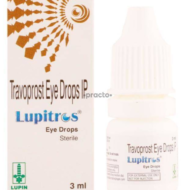Buy Travoprost Online
Travoprost, sold under the brand name Travatan among others.
| Active substance: | Travoprost |
| U.S. Brand: | Travatan |
| Indian Brand: | Lupitros |
| Mfd by: | |
| Strength: | 0.004% |
| Form release: | 3ml bottle |
| Shipping time: | 7 – 21 days |
| Best price: | 12.00 USD |
| Order: | through request form |
Travoprost, is medications used to treat high pressure inside the eye including glaucoma and ocular hypertension (a condition which causes increased pressure in the eye). Travoprost is in a class of medications called prostaglandin analogs. It lowers pressure in the eye by increasing the flow of natural eye fluids out of the eye.
Specifically it is used for open angle glaucoma when other agents are not sufficient. It is used as an eye drop. Effects generally occur within 2 hours. This medication works by regulating the flow of fluid within the eye to maintain a normal pressure.
To instill the eye drops, follow these steps:
- Wash your hands thoroughly with soap and water.
- Check the dropper tip to make sure that it is not chipped or cracked.
- Avoid touching the dropper tip against your eye or anything else; eye drops and droppers must be kept clean.
- While tilting your head back, pull down the lower lid of your eye with your index finger to form a pocket.
- Hold the dropper (tip down) with the other hand, as close to the eye as possible without touching it.
- Brace the remaining fingers of that hand against your face.
- While looking up, gently squeeze the dropper so that a single drop falls into the pocket made by the lower eyelid. Remove your index finger from the lower eyelid.
- Close your eye for 2 to 3 minutes and tip your head down as though looking at the floor. Try not to blink or squeeze your eyelids.
- Place a finger on the tear duct and apply gentle pressure.
- Wipe any excess liquid from your face with a tissue.
- If you are to use more than one drop in the same eye, wait at least 5 minutes before instilling the next drop.
- Replace and tighten the cap on the dropper bottle. Do not wipe or rinse the dropper tip.
- Wash your hands to remove any medication.
- eye pain or irritation
- blurred vision
- dry eyes
- eye tearing
- headache
Travoprost eye drops may change the color of your eye (to brown) and darken the skin around the eye. It may also cause your eyelashes to grow longer and thicker and darken in color. These changes usually occur slowly, but they may be permanent. If you use travoprost eye drops in only one eye, you should know that there may be a difference between your eyes after using travoprost eye drops. Call your doctor if you notice these changes.
Submit your review | |


